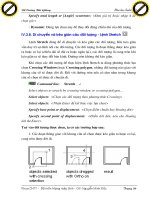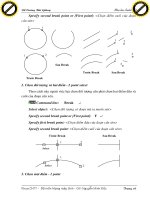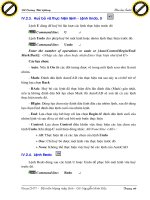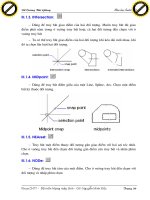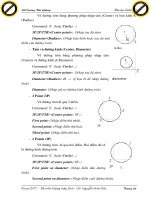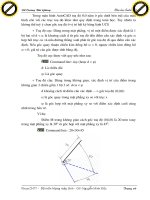Giáo trình phân tích khả năng ứng dụng các lớp giao diện boolean trong Androi để tạo một View riêng p6 pdf
Bạn đang xem bản rút gọn của tài liệu. Xem và tải ngay bản đầy đủ của tài liệu tại đây (388.18 KB, 5 trang )
dùng ACTION_SEND hay ACTION_SENDTO.
Việc đặt tên action cho intent đúng tên gợi tả còn có một ý nghĩa khác đó là
app của bạn có thể được triệu gọi từ một app khác. Ví dụ bạn viết một app có
activity đáp ứng intent ACTION_SEND và để chia sẻ một bức ảnh lên trang web
của bạn (giống như ta làm với Facebook, Flickr etc.) Khi đó có thể app của bạn sẽ
là một lựa chọn chia sẻ ảnh của người dùng điện thoại.
III-Sử dụng Intent như thế nào?
-Các hàm thực thi Activity
-Intent tường minh thực thi Activity
• Như đã trình bày ở phần II, intent có thể dùng thuộc tính phụ component để chỉ
định đích danh tên lớp sẽ thực thi Activity. Để thực hiện điều này, lớp Intent cung
cấp các hàm đó là setComponent(ComponentName) và setClass(Context, Class) và
setClassName(Context, String) setClassName(String, String).
• Chỉ được dùng để gọi các Activities trong cùng một app
• VD:
PHP Code:
Intent intent = new Intent();
intent.setClassName("ten_package", "ten_lop_ben_tr
ong_package");
startActivity(intent);
-Intent không tường minh thực thi Activity
• Trong trường hợp này intent không chỉ định một lớp cụ thể mà thay vào đó dùng
các dữ liệu khác (action, data, type, etc.) và để hệ thống tự quyết định xem lớp nào
(app nào) sẽ thích hợp để đáp ứng intent đó.
• Thông tin action và category của activity trong một app đáp ứng intent đó phải
được khai báo trong Manifest của app (AndroidManifest.xml) dưới dạng Intent-
filter (tất nhiên nếu chúng ta muốn gọi một built-in action thì ta không cần quan
tâm đến vấn đề này). VD:
PHP Code:
<activity class=".NotesList" android:label="@strin
g/title_notes_list">
<intent-filter>
<action android:name="android.intent.action.GE
T_CONTENT" />
<category android:name="android.intent.categor
y.DEFAULT" />
<data android:mimeType="vnd.android.cursor.ite
m/vnd.google.note" />
</intent-filter>
</activity>
IV-Truyền nhận thông tin giữa các Activity sử dụng intent
-Giả sử ta xây dựng một app có hai activites A và B như hình vẽ trên. Khi đó bên
phái Activity A ta sẽ gọi hàm:
PHP Code:
startActivity(intentA,request_code)
-Bên phía Activity B ta sẽ gọi hàm:
PHP Code:
setResult(return_code, intentB);
Trong phần 1, mình đã trình bày những kiến thức cơ bản về Intent. Tiếp theo mình
sẽ hướng dẫn các bạn làm một Tutorial đơn giản để hiểu rõ hơn những vấn đề nêu
trong lý thuyết.
-Giả sử bạn cần viết một app để tính các phần tử của một dãy số được cho
theo quy luật:
PHP Code:
a0,b0 nhập từ bàn phím
a(n+1)=a(n)+b(n)
b(n+1)=a(n)*b(n)
Để thực hiện, chúng ta xây dựng hai Activities 1 và 2. Activity 1 sẽ làm nhiệm vụ
lấy dữ liệu nhập vào sau đó gọi Activity 2 tính toán kết quả và lấy dữ liệu trả về.
Người dùng sẽ quyết định tiếp tục tính toán hay reset lại từ đầu. Toàn bộ quá trình
này được minh họa như hình vẽ dưới đây:
-Đầu tiên bạn tạo một New Project như sau:
PHP Code:
Project Name: IntentBasic
Target: bất kỳ (vd 1.5)
Package name: com.vietanddev.intent
Application name: Intent Basic
-Tiếp theo bạn tạo layout cho hai Activities như hình vẽ dưới
input.xml
PHP Code:
<RelativeLayout xmlns:android="roid.c
om/apk/res/android"
android:id="@+id/RelativeLayout01"
android:layout_width="fill_parent"
android:layout_height="fill_parent">
<TextView android:id="@+id/TextView01"
android:layout_width="wrap_content"
android:text="A = "
android:layout_margin="20dip"
android:layout_height="wrap_content"></TextView>
<EditText android:id="@+id/txtNum1"
android:text="0"
android:layout_width="fill_parent"
android:layout_height="wrap_content"
android:layout_alignBottom="@id/TextView01"
android:background="@android:drawable/editbox_backg
round"
android:layout_marginRight="10dip"
android:layout_toRightOf="@id/TextView01"></EditTex
t>
<TextView android:id="@+id/TextView02"
android:layout_width="wrap_content"
android:layout_below="@id/txtNum1"
android:text="B = "
android:layout_margin="20dip"
android:layout_height="wrap_content"></TextView>
<EditText android:id="@+id/txtNum2"
android:text="0"
android:layout_width="fill_parent"
android:layout_height="wrap_content"
